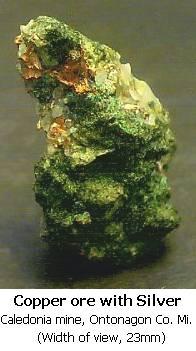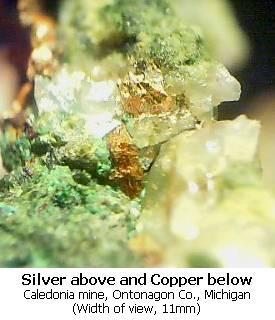Planning for this trip began in August of 2007 during a trip with my Dad to several locations in Marquette county. (
Click Here for Prior Trip Report) At the time, I figured that if he had a good time in Marquette county, he would really like the Keweenaw region. In October of 2007 while attending the rock and mineral show at the Mason fairgrounds I spoke to Richard Whiteman, owner/operator of the Caledonia mine. He mentioned the possibility of setting up an underground claim mining type of event. This sounded like just what I was hoping for.
We waited until February of 2008 when the schedule of events for the Copper Country Mineral Retreat was posted on the show’s website. One event set up for Tuesday August 5th was “Caledonia, limited access underground collecting.” This sounded like the closest thing to what I had talked to Richard about, so when registration opened up, my Dad and I sent in our forms, which signed us up for trips to the Caledonia and the Champion copper mine for surface collecting. About a month before the trip we worked out the details. I would spend the weekend in the Ishpeming area to go to the fieldtrips and show there, and meet up with my Dad at McLain State Park in Copper country Sunday night.
Thursday, July 31st
Left home at 9:00am under perfect sunny skies. Some time a little north of Mt. Pleasant I noticed my “service engine soon” light had come on. I hoped that wouldn’t become a big part of this field trip like it was the last one.
Made it to the Mackinaw Bridge by 12:30 and bought lunch and dinner at the Subway in St. Ignace. Had to take a detour around the Cut River bridge since it’s repair wasn’t done yet. This time I took hwy 117 north through Engadine to visit the Mobile station there, and then west on hwy28. I got to Marquette by 4:30, and Ishpeming by 5:00 where I stopped at the IGA for supplies. Then it was on to Van Riper state park to register for the next three nights. I had my dinner and ate some Ben and Jerry’s ice cream (yum!). After that there was still some daylight left, so I decided to do some scouting of nearby mines I had learned about recently. One was the Ohio mine near Imperial Heights. It turns out that this mine is now gated private property, so collecting there is out of the question. Then I found the general location of the next mine, which is in the same geological formation as the Michigamme mine, but this location is relatively unheard of by collectors. Not knowing exactly where the tailings piles were, I left the area and returned to camp to get ready for the next day’s field trip.
Friday, August 1st
Got up at 7:15 and had my Raisin Bran and cinnamon roll breakfast and left to meet the rest of the group at the Pamida parking lot in Ishpeming. The first person there was Gary Richards, who is the auctioneer for the annual live auction. He said that he had about twenty people coming from a Wisconsin group who had never been to Mt. Shasta before. It wasn’t long and a large group was assembled, everyone donating the $5.00 and signing the waiver form. I talked to a club member named Glen who I’ve met on previous field trips about the other mine I had searched for the previous night. He said he had been there once before, and expressed an interest in showing me the spot after the group was finished digging. Soon we had a long convoy of vehicles going west on hwy41, finally parking along the highway in front of the mine. Walking up the short hill, the group was already filing through a hole in the fence. I didn’t waste any time locating my spot on the north side of the tailings pile. I picked a spot that had several years of vegetation on it showing that no one had dug in that spot for quite a while. As I started digging into the hillside with my Estwing geo/ paleo pick, a lady picked a spot on my left and said, “so you just start digging?” I said yep, and pointed out that, considering the fact that this mine has been hunted for years, you probably would have to do quite a bit of digging to find the really good garnets. She introduced herself as Kathy from Crystal Falls. This was her first time at Mt. Shasta, and not long into digging I pulled out a big nicely shaped crystal and said, “That’s what your looking for!” she was surprised at the nice crystal shape. I asked her to take a picture of me with my find, and here’s how it turned out.
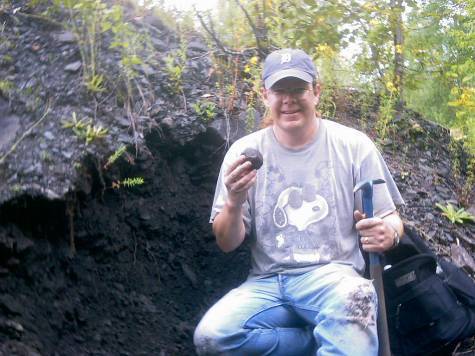
Highgrading would be the order of the day at Mt. Shasta since I already have quite a few of the pseudo garnets from there, so throughout the course of digging I gave away a few smaller crystals I found to some of the first timers including Kathy. She started finding some nice garnets in her spot too. One in particular had good size and well defined natural facets.
My find of the day was the biggest well formed garnet I’ve ever found there. This one is just about the size of a baseball.
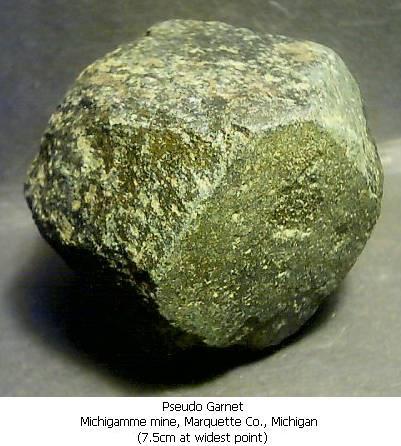
Another one I found that day is also large, and the natural facets are in excellent condition.
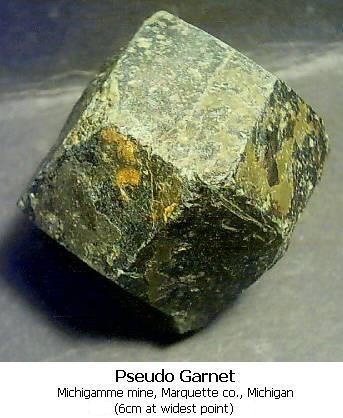
The group finished up by 12:30, and as I stepped back out through the hole in the fence I caught up with Glen who asked if I still wanted to go to ‘site #2’ as I’m calling it. I got in the van and followed him down the road a way to the spot I had found the day before. We parked our vehicles and he led me on a short walk through the woods. We walked past obvious tailings piles with mature pine trees growing on them, to a place between two water filled pits with high rock sides. Here the black chlorite was exposed and I found a good sized rock with some nicely formed sprays of Grunerite.
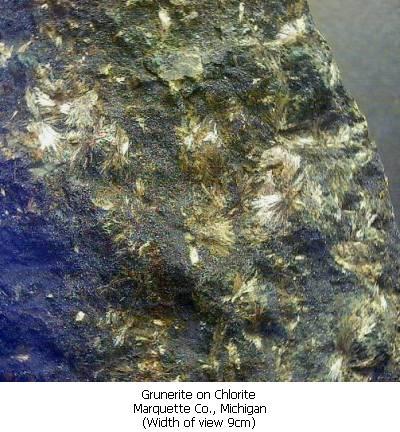
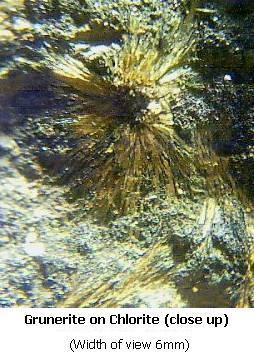
Glen had things to do, so he left before I did, and I decided to return the next day for some more serious garnet hunting. I went back to camp, got cleaned up and had some lunch. With most of the afternoon still ahead, I drove into Ishpeming to see what was going on at the Cliffs Shaft Museum, home of the Ishpeming Rock and Mineral Club, of which I am a long distance member. As I drove up, my buddy Doug who was talking to another club member gave a wave. We got to talking and he mentioned some gold from the Ropes gold mine that he recently bought in a collection. We went back to the club rock lab and I looked through what he had, and picked out this nice little specimen.
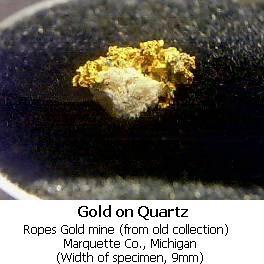
During this conversation I also learned that the Republic mine has new owners, and mineral collecting is no longer allowed. I bought some Jaspilite slabs from Doug for a future project and let him get back to work loading his trailer for the show in the morning.
I drove into Negaunee for some dinner at the Subway there, got some more ice cream at the IGA and returned to camp for the evening.
Saturday, August 2nd
I got up early and made it to the Ishpeming Rock and Mineral Club’s 33rd annual rock show by 9:30.
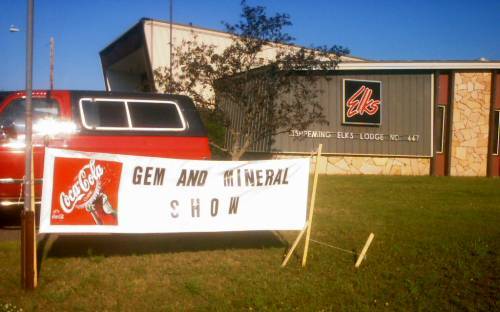
There were a few less dealers there this year, but quality material was still to be had. Gene LaBerge had a stand set up selling his book, “Geology of the Lake Superior Region.” It didn’t take long to decide that this should be with the rest of my rock books. This is written for the ‘layperson’ and has a glossary in back to define the geological terms. I’ve only started it, but I can already tell that for anyone interested in the minerals around Lake Superior this book would be a fine addition to the library. Gene autographed the book for me and I thanked him and moved on. I bought a t-shirt and a lighted loupe, and looked at the displays until around 10:30 and then left for Site #2 to dig for some pseudo garnets.
Arriving, I parked in the same spot as the day before, sprayed down with some bug spray, grabbed my gear and hiked into the woods. I passed the same overgrown tailings piles as I did yesterday and took a quick look around in the area between the two flooded pits. After this I returned to those overgrown tailings piles and looked for a likely spot, hopefully one that wouldn’t have too many obstacles in the way. Finding a spot, I removed the debris covering the rocks, and began to remove larger pieces of chlorite rock away from the pile to expose the smaller material with loose garnets. In this shaded damp woods the mosquitoes were getting thick quickly. I dug for about an hour and a half until the mosquitoes were so bad I couldn’t stand it anymore, but did manage to find a handful of medium and small sized pseudo garnets, plus an interesting piece of Magnetite.
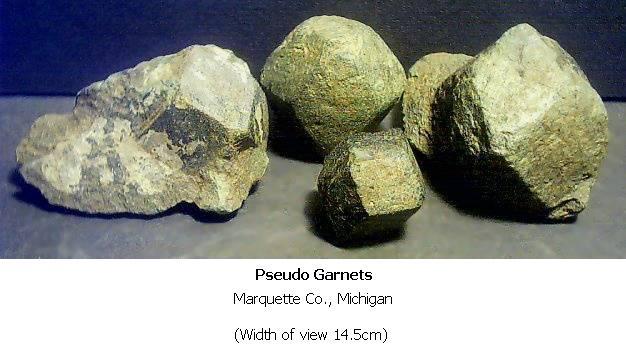
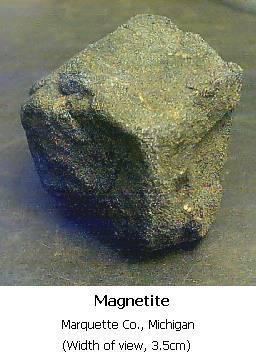
As an offering to the site (or the next rockhound that goes through there), I left a small nicely formed garnet on one of the larger rocks I had moved. After that I filled in the hole the best I could and stood back a few feet to see the small cloud of mosquitoes that had been swarming me. Soon they found me again so I walked back to the van and returned to camp to get cleaned up and have a late lunch.
For the afternoon I drove back to the rock show in Ishpeming, and spent a while there looking through the ever changing tables of silent auction specimens. After looking around in the outdoor vendors area one last time I crossed the street to walk through the Renaissance Fair that is held every year at the same time as the rock show. When finished there, I drove to Negaunee to get dinner and then to Jackson park in Negaunee. It was a hot day, and the tall trees in Jackson park made some welcome shade. After eating, it was close to 6:00, so I found the ‘back way’ into the parking lot at the Cliffs Shaft museum. This year’s presentation and live auction were held in the mineral collection room at the museum instead of the Elk’s Club like years past. By the time I got there people were already finding their seats. Gary Richards from Wisconsin who usually does the live auction for this event was also giving the presentation. A slide projector was set up and around 7pm Gary, in his usual entertaining way started telling us about the Montreal mine in Iron County, Wisconsin. This mine started up in the late 1800s and ceased operations by the mid 1960s. One interesting point about this mine was that the management tolerated specimen collecting among employees. When a new pocket was opened up management got the first pick of specimens (naturally), and the miners could get away with taking home lunchboxes full of nice specimens. The collecting tolerance must have been a good morale boost for everyone involved. Gary showed some great slides of miners working at the mine in the 1950s along with slides of some of the fine specimens taken from this mine. The pictures included large botryoidal Manganite as well as Rhodochrosite and others. At the end of the presentation Gary got a good round of applause and quickly moved on to the live auction. There were lots of nice items up for auction including donations from Kingsley North and Da Yooper’s rock shop, but the highlights of the night were two Manganite specimens that were part of the IRMC mineral collection. The Manganite was from the Lucy mine in Negaunee, and these were museum quality. One was in the tightly compacted needle form (rare for this mine), with crystals about two inches long. This one ended up selling for over $300. The next was another museum quality Manganite specimen, this time in the botryoidal form. This beauty ended up selling for around $450. I had hopes of buying one of these nice pieces, but I could tell that these local club members wanted them much more than I did. Door prizes were given out through the night, and I waited until right near the end and made my way to the exit. Stepping through the door I heard my number called. Checking my pockets I couldn’t immediately find my ticket, so I shrugged and continued on to the van. I returned to Van Riper campground and checked in with Litha by phone, and then settled in for the night.
Sunday, August 3rd
Since the field trip to Lindberg’s quarry wouldn’t start until 1:00pm, I had all morning to fill. I drove to Negaunee’s Cornish Town park. I parked the van near the entrance to the north Jackson mine, checked out the mine area for a few minutes, and left on my morning walk. An older man passed me on his walk who mentioned that there were around 8 miles of walking paths in the park. I decided to take a path I had never been on before, so I found a path that was actually an old sidewalk that had been recently uncovered. The sidewalk led on a long upward slope until at the top of the hill the path turned gravel and veered left and down around a big fenced off mine pit. This was the first time I had seen this mine pit. As I descended left along the fence I could see glittering piles of Hematite exposed in the morning sunshine. The path dropped down to a point near the road that led back to the van. On the way back to the van, on my right was yet another mined out pit with Hematite tailings piles that I had never seen before. This whole area must have been a big Hematite vein, and the early miners made good use of it. Large hills of iron ore were removed from this rolling countryside.
All this time I had been trying to decide whether to go to Lindberg’s Quarry, or just head up to Houghton and the mineral sale at the Seaman museum. If I went to the quarry I would only have about 15 minutes of collecting time before I had to leave. The museum sale started at 3:00 and I wanted to be there at the beginning, so that was that, I would skip the quarry. With a little time to spare I walked through an antique shop on hwy41 in Negaunee, and around 1:00 I left for Copper country. It was another hot day, and I stopped for lunch in one of the few shady spots in a roadside park along 41. I stopped at the Pines casino gas station for the best prices on gas around, filled up the tank, and made it to the parking lot at Michigan Tech by 2:30. There was already a small crowd of people there when I got to the Seaman museum, so I joined them in their mulling and waiting for the paper covers to come off the sale tables. Finally the museum staff came out and began to remove the covers and the crowd of eager buyers swarmed the tables, myself included.
One specimen I couldn’t resist was this nice Rhodochrosite from Peru.
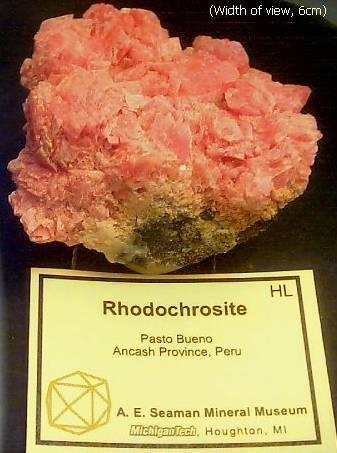
The busiest table seemed to be the Datolite table with quite a few specimens to chose from. I was saving my Datolite purchase for the sale at the Quincy mine coming up Tuesday night, so I looked for other goodies. I picked up 8 or 10 new pieces for my collection and went through the museum’s check out process, and then I left Houghton to meet my Dad at McLain State Park.
I had planned it so that I would get there before him, but as I drove up to the campsite he was already there with his tent laid out and ready to set up. Here’s a picture of our camp after the tent was set up. My Dad’s at work getting a campfire started.
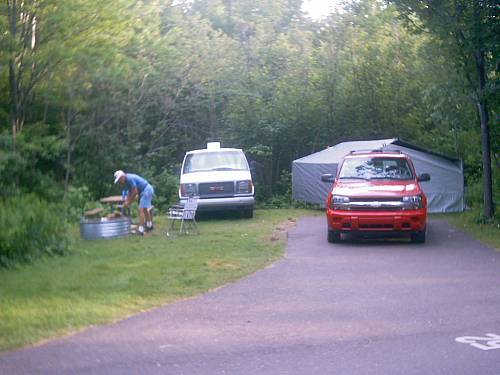
We ate our dinners, sat by the fire and made plans for the next day, until darkness fell and the fire died out. I climbed in the van and tried to get caught up on this journal by the light of a flashlight. It wasn’t long and I had to give it up and get some sleep. Overnight there was rain overhead and lightning in the distance.
Monday, August 4th
Today we weren’t signed up for any official events, and I wanted to try my luck digging at the Delaware mine. As we left camp I mentioned to my Dad that I had better bring my camera, joking, “…just in case we see a Bear or something…” , and wouldn’t you know it, as we were driving on hwy26 between camp and Calumet a full grown Bear ran across the road. To my eye it looked like it was wearing a radio collar, but I couldn’t be sure about that. It happened so quickly that I didn’t get a picture even though the camera was right next to me. After that excitement we stopped in Calumet for some supplies and drove hwy41 north/east to Delaware. There were already three cars parked at the entrance to the tailings pile when we arrived. I recognized one of them as the cowboy hat wearing agate dealer who is always set up at both the Ishpeming and Quincy mine sales every year. They were searching on the right hand side of the pile, so we moved over to the left side and started hunting. One thing I noticed was that the whole front area of this pile had been bulldozed earlier in the year. This meant that my plans for digging down to the ‘older’ layers had to be adjusted, since a bulldozer would just mix up the layers. I just picked a spot not too far above ground level and started moving rock. I soon realized that I might want my metal detector to pick out pieces of copper as I dug, so I retrieved it from the Trailblazer and got back to digging.
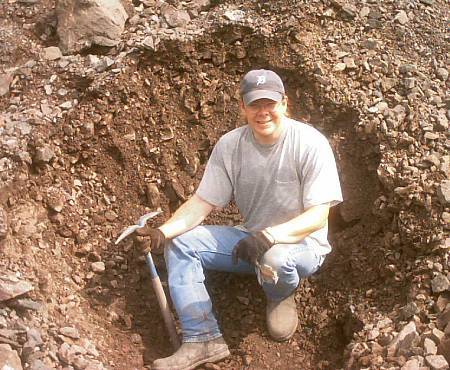
I wasn’t having any luck finding Datolite, and most of the Copper I found was pretty uninteresting. Here’s a picture of the best one, cleaned with water only.
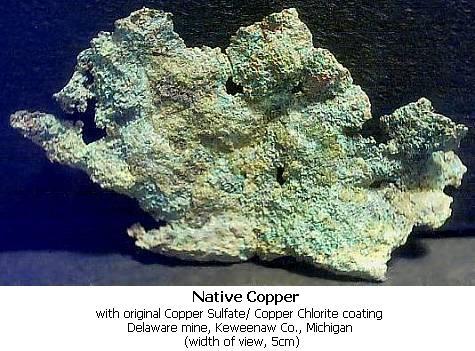
Finally I had dug so deep that cold air started coming up from the rocks below.
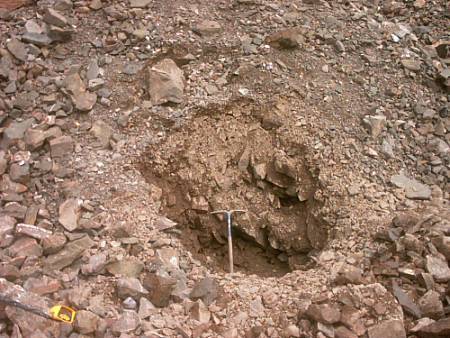
I didn’t know what was causing that, but I wasn’t going to tempt fate. No doubt someone will come back there after a good rain and find Datolite sticking out like a sore thumb, but that’s how it goes. I kicked in as much rock as I could to fill in the hole, then poked around a little in other spots on the pile, and then returned to the Trailblazer.
Next we went north on 41 to Copper Harbor and to the end of the road, where I showed my Dad the two-track that leads out to the beach. The road at the entrance is deceptively smooth. More about that later. We decided that we would come back later in the week and try to get to the beach. From Copper Harbor we took hwy26 west a few miles and stopped at one beach access area. There was a small group of people suiting up with scuba gear. My guess was that they were hunting agates in the water. The shoreline here is a basalt conglomerate where I’ve been told you can break agates right out of the rock. This area has long since been picked over and I didn’t find any agates in the rock. I did pick up a couple of possible agates from the water there. We stopped at one more beach along that stretch of road before turning back towards camp for the night. The next day was one of the big events of the trip, and we rested up for an early start.
Tuesday, August 5th
This day we were up early and on the road by 7:45. Our event at the Caledonia mine started at 9:00 and I estimated a 45 minute trip. In fact we needed all of that hour and fifteen minutes and got there just in time. The group was there getting hard hats and power packs ready. While I was getting my gear on Richard Whiteman was talking to the group and he mentioned that we would be climbing a ladder up to the stopes. This was just what I had hoped for. I helped my Dad get his gear on and soon the group was off into the main adit of the Caledonia mine. Cool damp darkness, and water dripping from the ceiling. Not far into the mine I reacquainted myself with the resident bats, navigating the darkness of those passages in silent grace.
We were led to an aluminum extension ladder that reached to an opening high on the right side of the adit. I was the closest one to the ladder, so I followed the guide up, who directed me up a narrow path to the left, and into the first stope. Richard had said that a stope is defined by a set of pillars which divide off these rooms or stopes where the ore was mined out. Dad and I stopped right at the top of the first stope where I used my 3 pound sledge to break a piece of Copper off a larger rock. My first underground photo of this event was taken to my left from this position.
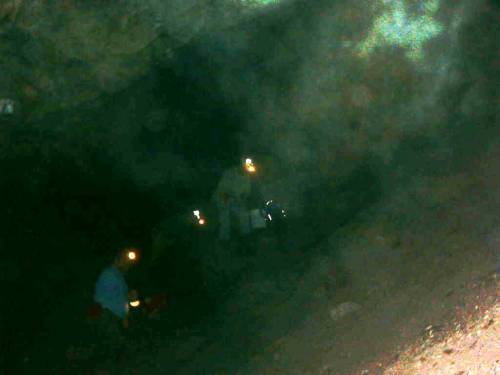
I dug around there for a while but didn’t have a lot of luck, so I moved over two stopes to the right. No one else was there yet, so I stayed near the entrance where the others were still in sight. The floor here was quite steep, so the first thing I did was to make a good enough shelf to stand on. One of our guides came in an started digging on my right. I asked him if the Silver here was bright, or would it have a black oxidation on it? He said it would be bright and shiny. Soon his partner came in and took over where he had been digging. At one point I got her to take this rather eerie picture of me in my spot.
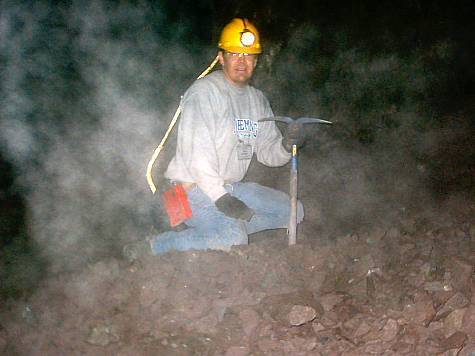
I kept just about anything that looked or felt like Copper. The bats were squeaking around us, seemingly irritated by our presence. By the end of an hour and a half my back pack was getting heavy and it was time to leave. I got this picture as we were coming down the ladder. You can just make out the ladder in the background. That’s my Dad, Jack Adams on the right.
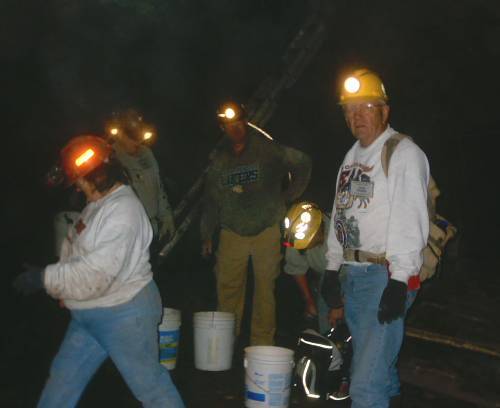
We were led quickly down the tunnel to the exit, and right on cue I hit the warm outside air and my glasses steamed up. I got this picture as we exited the mine.
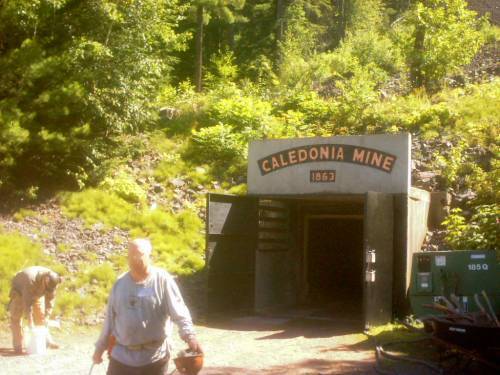
Back at the wagon where everyone was setting their gear, I rested my Estwing hoe/pick up against the wagon and began to talk with Richard. I offered to send him a link to this report when it was finished. After our conversation I noticed two members from the Ishpeming club and went over to talk to them for a while. Can you guess where this is leading? Yep, I walked away and left my Estwing pick leaning right against that wagon. Not realizing it at the time, we drove back north to camp and had our lunch. I sorted out my finds and my Dad got out what he found, including three cauliflower shaped lumps that looked like Datolite nodules. In fact, that’s exactly what they are. Here is a picture of the three nodules together.
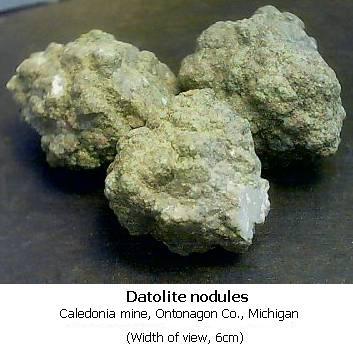
I’ve managed to cut and polish one at this point, and it’s a nice one!
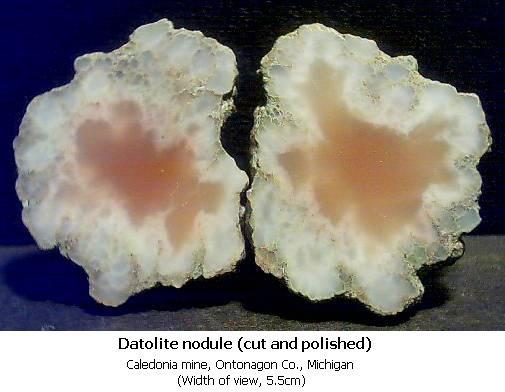
My Dad was able to do something on his first trip that I haven’t done in several collecting trips, find some nice Datolite.
Here are three of the interesting smaller pieces of Copper I found.
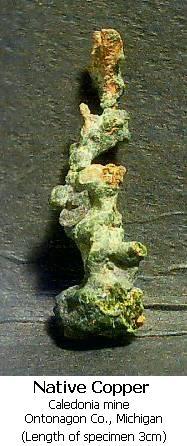
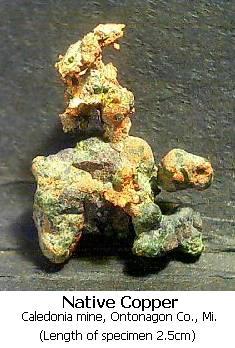
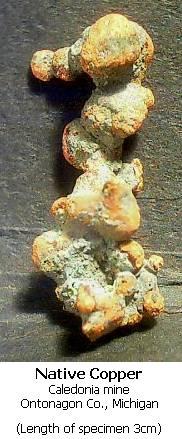
While digging up in that stope I found the biggest and one of the best pieces of Copper ever in three years of collecting. I haven’t found any Silver on it but regardless it is a good, thick, well formed piece of native Copper. This is the best picture I could get.
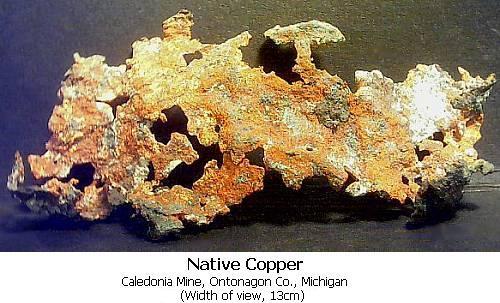
That night was the Quincy mine sale, but we still had a few hours to burn so we went for a drive along the Keweenaw peninsula’s eastern shore, my Dad looking for fishing prospects, and me looking for good rocky beaches. We drove through road construction into Lake Linden and up along the shoreline, where most of the beaches were sandy with few rocks. At one spot with room to park and a path to the beach we found small tart wild blueberries ready to eat. We stopped long enough to eat a few berries and realize that the beach here was just as unpromising. Eventually we turned back, through Lake Linden, through the road construction, and stopping in Calumet for supplies. Then it was back to camp to eat dinner (I shared my personal pizza with a friendly chipmunk), and then back on the road to the Quincy mine sale, which was supposed to start at 7:00pm but when we got there at 6:30 the sale was going strong. My Dad walked around the grounds while I checked out the vendors and bought this yellow Datolite.
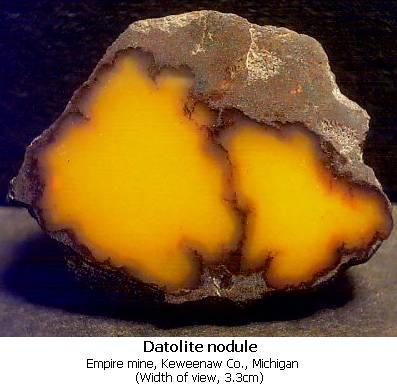
I recognized the cowboy hat wearing agate dealer with all his nice agates. When I was finished shopping I caught up with my Dad and we took back roads on our way to camp. At dusk we packed it in and got ready for our last full day in the Keweenaw.
Wednesday, August 6th
The field trip this day was to the Champion #4 Copper mine in Painesdale. I did pretty well at this mine last time I was here, so my hopes were up for this return trip. It was when I was packing the Trailblazer that I realized that my Estwing hoe/pick was missing. It took a while to remember where I left it at the Caledonia mine the day before, and since we were going in that direction anyway, my Dad offered to drive us back there after the morning’s event. The Caledonia was still nearly an hours drive south of Painesdale, and I was concerned that it might be a wasted trip, so I thought about it while we searched the parking lot and dozed areas at the Champion mine. We weren’t allowed to go near the tall piles.

This time the Copper I found there was in ore form; Basalt, Calcite and other minerals shot through with pure Copper. This is a picture of a couple of representative pieces.
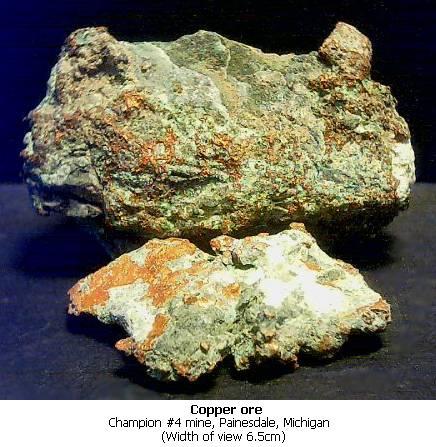
Not having much luck, by the time 11:30 came along I was ready to be done. I had decided that it would be worth the try to drive down to the Caledonia mine and see if they found my pick. We drove down to the parking area at the Caledonia mine where Richard and a small group were having lunch. I asked about my pick and was told that they had it. Richard mentioned that it looked like it had hardly been used. I told him that I had just bought it this spring. I thanked him for saving it for me and we headed back to our camp. This is just one more story of what great people rockhounds are. It would have been very easy to walk off with that pick and put it in your car, but that didn’t happen. Instead I have my pick back and all is well. I guess the trip down wasn’t a waste of time after all.
On our final afternoon in Copper country we were going to try and make it out to the point at Copper Harbor. After lunch we drove north/east on hwy41 until we came to a roadblock and a detour onto hwy26 through Eagle River and Eagle Harbor. This is a nice scenic drive, but since we were a little pressed for time we didn’t get to enjoy the highlights. We took the winding road north of Eagle Harbor and finally through Copper Harbor to the entrance of the two-track atv/logging road. At first the road was in good shape, but soon we encountered large pot holes to navigate around. One thing that surprised us both was the traffic. Every rockhound in the area must have seen this road on the map and made that beach a destination just like I did. We got to a point where the road just got too bad and we had to turn around, but on that trip we must have passed 15 vehicles going to or coming from the beach. Instead we drove back down hwy26 to Eagle Harbor to a collecting spot I had heard about. I tasted my first wild ‘thimbleberry’ and nearly got carried off by mosquitoes. I had also been told that if you’re ever in Eagle Harbor, to check out the cemetery there for it’s interesting iron work and woodland setting, so we spent a few minutes there and then drove back to Calumet to pick up some food to take back to camp. After dinner an ominous line of clouds formed on Lake Superior and about a half hour later a rain shower came through that didn’t last very long. Just long enough to get everything wet and bring the mosquitoes out. We called it a night and rested up for the next days driving.
Thursday, August 7th
My Dad was up before me, and by the time I hit the morning light he had most of his tent down. He only needed help folding a couple of the larger pieces and he was ready to go. We said our goodbyes and he left ahead of me. There was one more place I wanted to check out before leaving the region. I had been told about a beach on the Keweenaw peninsula’s north/west shore that might be a good agate hunting beach. So I drove off to find that beach. I missed the road on the first pass and then found what turned out to be a two-track logging road. The end opened out to a nice beach covered with rounded stones. When I got there I had the beach to myself, but other cars were coming in my wake. I spent about an hour walking the beach finding a few possible agates. By then people had started gathering on the beach and it was time to go. I counted six or seven vehicles on that logging road that morning.
Back out on hwy41 I made my way south over the big lift bridge between Houghton and Hancock, and then back east towards Marquette county. For lunch I stopped at a roadside park I’ve been meaning to stop at for a while now. It’s called Canyon Falls roadside park and has a nice trail down to a series of falls that do in fact end up in a small canyon. I got this panorama of the main falls.

My next destination for this day was Lake Ellen, so I drove through Champion and then south on hwy95 to Channing and the Lake Ellen turnoff. I spent about a half hour at the collecting site there and found a few red Pyrope garnets, none of them faceting grade.
Next I headed out in the direction of Norway, Michigan and Kingsley North, a lapidary supply with just about anything you can think of. I went looking for some of the Ruby in Zoisite that I passed on this spring, but they were out of it. Instead I bought some nice African Malachite and African Blue Lace Agate for later projects. Then I drove east on US2 to see how far I could get before needing a campsite for the night. I gassed up and got dinner in Escanaba and then continued on eastward down US2. It was about 7:00pm by the time I got to the Hog Island campground. I pulled in and found a great campsite facing straight south down Lake Michigan from one of the most northern parts of the lake. I got out the cell phone and let Litha know I would be home fairly early the next day. Even with this site facing the beach, the mosquitoes were out and thirsty, so I got in the van and ate dinner, and then tried to make some headway on my travel journal. While writing I looked out the front window of the van to see a million dollar view. The sun was setting off to my right and the southern sky was turning from golden to orange in contrast with the deep blue of the water. This picture doesn’t really do it justice, but you can get an idea.
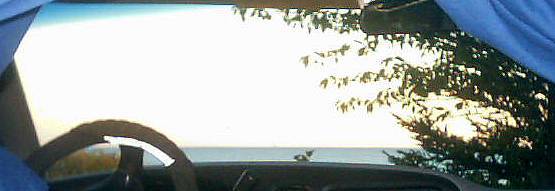
The view was quite a distraction from writing in the journal and eventually I pulled the curtain and called it a day. As eager as I was to get home that sleeping bag felt good and I needed the rest.
Friday, August 8th
I was up early and had some breakfast, and then left Hog Island campground. I had decided to break with tradition and pass on the pasties and fudge that I usually get on the way home from these trips. Instead I would drive straight through stopping only once to pull off my sweatshirt. Things were a bit warmer in southern Michigan. Traffic was busy as usual and there were the gratuitous construction zones to navigate, but I made it home shortly before noon and had no problems with the van.
It was another good trip rockhounding with my Dad in the UP, highlighted by our journey into the stopes of the Caledonia mine. On that note, I will end this report with two last photos of a little piece of Copper ore with the only Silver I have identified from this trip so far. Thanks to Richard Whiteman for the great collecting trip and the people at the Seaman museum for organizing this week, as well as the Ishpeming Rock and Mineral Club for a good show, presentation, and field trip. Thanks for reading!
